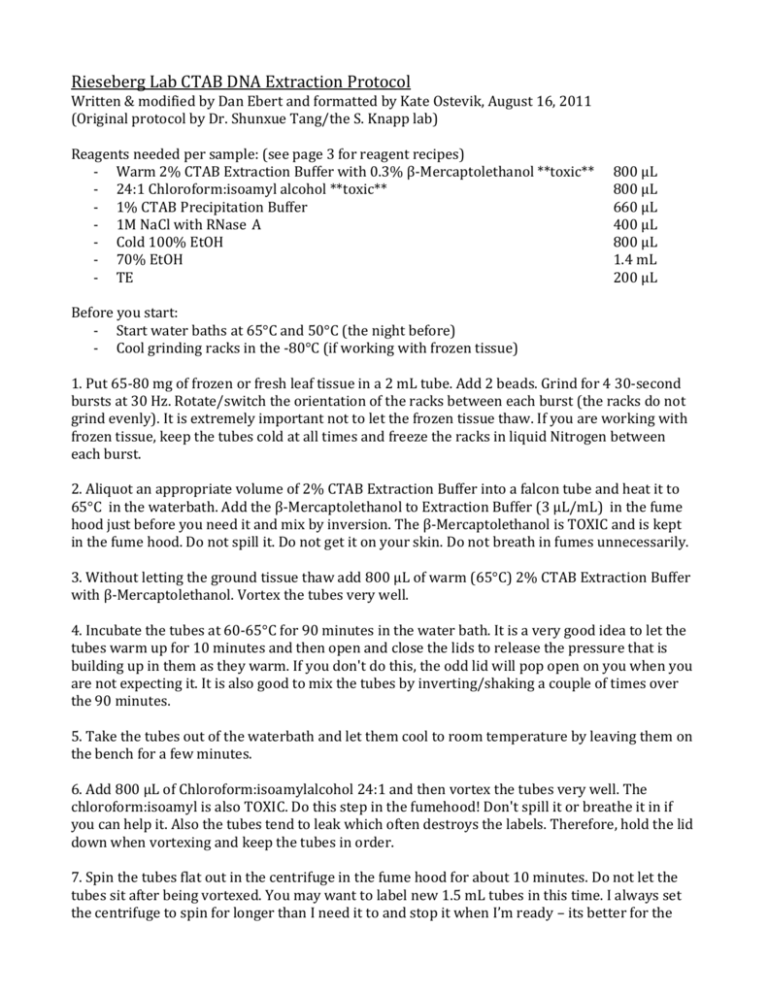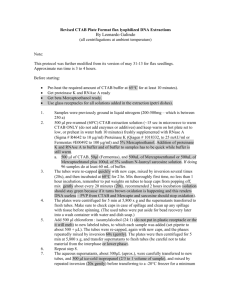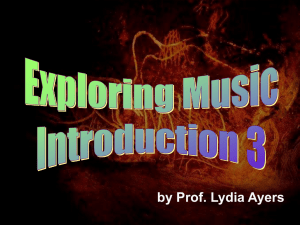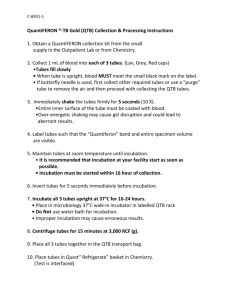Protocol
advertisement

Rieseberg Lab CTAB DNA Extraction Protocol Written & modified by Dan Ebert and formatted by Kate Ostevik, August 16, 2011 (Original protocol by Dr. Shunxue Tang/the S. Knapp lab) Reagents needed per sample: (see page 3 for reagent recipes) - Warm 2% CTAB Extraction Buffer with 0.3% β-Mercaptolethanol **toxic** - 24:1 Chloroform:isoamyl alcohol **toxic** - 1% CTAB Precipitation Buffer - 1M NaCl with RNase A - Cold 100% EtOH - 70% EtOH - TE 800 μL 800 μL 660 μL 400 μL 800 μL 1.4 mL 200 μL Before you start: - Start water baths at 65°C and 50°C (the night before) - Cool grinding racks in the -80°C (if working with frozen tissue) 1. Put 65-80 mg of frozen or fresh leaf tissue in a 2 mL tube. Add 2 beads. Grind for 4 30-second bursts at 30 Hz. Rotate/switch the orientation of the racks between each burst (the racks do not grind evenly). It is extremely important not to let the frozen tissue thaw. If you are working with frozen tissue, keep the tubes cold at all times and freeze the racks in liquid Nitrogen between each burst. 2. Aliquot an appropriate volume of 2% CTAB Extraction Buffer into a falcon tube and heat it to 65°C in the waterbath. Add the β-Mercaptolethanol to Extraction Buffer (3 μL/mL) in the fume hood just before you need it and mix by inversion. The β-Mercaptolethanol is TOXIC and is kept in the fume hood. Do not spill it. Do not get it on your skin. Do not breath in fumes unnecessarily. 3. Without letting the ground tissue thaw add 800 μL of warm (65°C) 2% CTAB Extraction Buffer with β-Mercaptolethanol. Vortex the tubes very well. 4. Incubate the tubes at 60-65°C for 90 minutes in the water bath. It is a very good idea to let the tubes warm up for 10 minutes and then open and close the lids to release the pressure that is building up in them as they warm. If you don't do this, the odd lid will pop open on you when you are not expecting it. It is also good to mix the tubes by inverting/shaking a couple of times over the 90 minutes. 5. Take the tubes out of the waterbath and let them cool to room temperature by leaving them on the bench for a few minutes. 6. Add 800 μL of Chloroform:isoamylalcohol 24:1 and then vortex the tubes very well. The chloroform:isoamyl is also TOXIC. Do this step in the fumehood! Don't spill it or breathe it in if you can help it. Also the tubes tend to leak which often destroys the labels. Therefore, hold the lid down when vortexing and keep the tubes in order. 7. Spin the tubes flat out in the centrifuge in the fume hood for about 10 minutes. Do not let the tubes sit after being vortexed. You may want to label new 1.5 mL tubes in this time. I always set the centrifuge to spin for longer than I need it to and stop it when I’m ready – its better for the tubes to be spinning rather than sitting. 8. Gently take the tubes out of the centrifuge and then carefully pipette the top, aqueous, layer off and into a new-labeled 1.7 mL tube. Make yourself comfortable at the fume hood and take your time. You may find the layers stay separated better if you take them from the centrifuge and process them one at a time, but if you have another batch of tubes to spin just take them all out into a rack. Take a 200 μL pipette and draw off 160-170 μL of the top layer on each of four pulls. Keep the pipette tip at the surface of the top layer and watch closely that you do not disturb the lower layers. Do not take any of the solid, whitish, layer or the chloroform layer at the bottom (which will often leak up onto the top of the white layer). It is better to leave some of the aqueous layer than to take some of the stuff you don’t want. You should end up with a bit less than 700 μL of recovered, DNA containing, aqueous solution in your new tube. Cap the old tubes and leave them in the fume hood until you have time to go back and tip each of them into the chloroform waste container. 9. Take the new tubes out to the lab and add an equal volume of 1% CTAB Precipitation Buffer to them (usually ~660 μL – you know this volume if you set the P200 to a particular volume in the previous step). Then mix by inversion 10 times or so. At this point you may be able to see a precipitate in the tubes but do not panic if you don't. Note that you can leave the tubes at 4°C for a break or even overnight at this stage. 10. Spin the tubes at 5000-8000 rpm for 5 minutes (you want the pellet to stick to the tube but you need it to resuspend quickly in the next step). Then, tip the supernatent off into a beaker. Try to get rid of as much as you can. Touch the open tube rims to a pad of paper towel to get rid of more of the supernatant. 11. Add RNase A (100 mg/mL) to 1 M NaCl. Add 5 μL of RNase A for each mL of 1 M NaCl. 12. Add 400 μL of the 1M NaCl with RNase to the tubes. 13. Incubate the tubes at 50 °C for 1 hour in water bath. Flick the tubes at the beginning of incubation in order to get the pellet up into solution. Do this again after about 10 minutes. If you have trouble resuspending the pellet let the tubes incubate for longer. 14. Put some 100% ethanol into the -20 °C at this point. 15. Add two volumes (usually 800 μL) of cold 100% EtOH to the tubes and mix by repeated inversion. You should now see nice fluffy and white DNA in each tube. Note that its ok to leave the tubes overnight at any of the ethanol steps. 16. Spin flat out (13000-15000rpm) for 5 minutes then pour off the EtOH. Add 700 μL of 70% EtOH and mix by gentle vortex and inversion. 17. Spin flat out for 5 minutes then pour off the EtOH again. Add another 700 μL of 70% EtOH and mix again. Let this sit for as ling as possible (preferably overnight). This may or may not make a difference but the idea is that any salts and CTAB might dissolve out of the DNA pellet. 18. Spin flat out for 5 minutes and pour off the EtOH again. Dry the pellets. I like to spin down the "empty" tubes then draw off the remaining droplet of EtOH with a 20 μL pipette then leave the tubes with their lids open for half an hour or so at room temperature. 19. Add 200 μL of TE to the tubes and re-suspend the DNA (warm the tubes to around 40°C and flick and invert them). Rieseberg Lab CTAB DNA Extraction Protocol Reagent Recipes: Stock solutions: 1 M Tris-HCl pH 8.0 0.5 M EDTA pH 8.0 1 M NaCl 60.55 g Tris Base in 500 mL ddH2O (adjust pH with concentrated HCl) 93.05 g EDTA in 500 mL ddH2O (adjust pH with ~10 g NaOH) 29.22 g NaCl in 500 mL ddH2O 1) 2% CTAB extraction buffer with 0.3% β-Mercaptolethanol **toxic** 100 mM Tris-HCl pH 8.0 0.7 M NaCl* 20 mM EDTA pH 8.0 2% (w/v) CTAB 1% (w/v) PVP40 0.3% BME (add just before use) *This was 1.4 M NaCl Stock 1M Powder 0.5 M Powder Powder Liquid 500 mL 50 mL 20.5 g 20 mL 10 g 5g 1.5 mL The β-Mercaptolethanol should be added to the rest of the extraction buffer as needed (see step 2 of the protocol). The β-Mercaptolethanol IS TOXIC and is kept in the fume hood. Do not spill it. Do not get it on your skin. Do not breath in fumes unnecessarily. Store the rest of the extraction buffer in a light proof bottle. 2) 1% CTAB precipitation Buffer 50 mM Tris-HCl pH 8.0 10 mM EDTA pH 8.0 1% (w/v) CTAB Stock 1M 0.5 M Powder 500 mL 25 mL 10 mL 5g Stock 1M 0.5 M 500 mL 5 mL 1 mL 3) TE 10 mM Tris-HCl pH 8.0 1 mM EDTA pH 8.0





